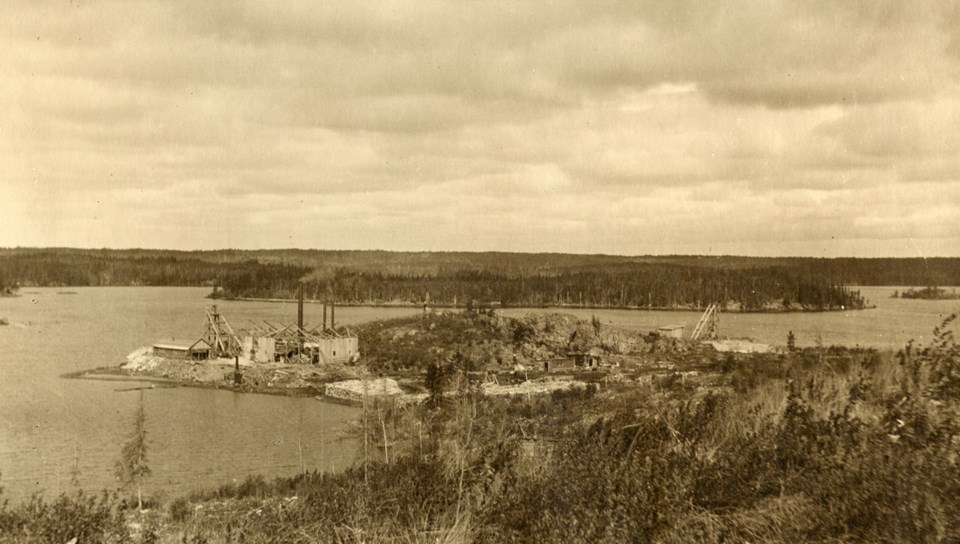The origins of Mandy Mine involve two men who were working as railroad builders by Hudson Bay. They decided that they wanted to take their own prospecting trip along Grassy River and see what was there. They had some knowledge of the area thanks to earlier surveyors, but they wanted to see it for themselves.
Fred Jackson and Sidney Reynolds decided to take the trip in the autumn of 1915 and see what they could find. Luck was on their side as they decided to camp on top of a 35-foot wide lens of solid chalcopyrite.
Over the next few months, the were able to pull out 22 to 28 per cent copper, which contained $3.60 worth of gold per ton, along with about nine to 16 ounces of silver. For every $1,000 they spent drilling into the find, $1.25 million in ore was brought out. It was pay dirt for the two men.
By October 1915, Jackson was in The Pas to register the claims of himself and Reynolds. The claim was named Mandy, after Mandy Jackson, Fred’s wife. He showed the ore to a representative from Tonopah Canadian Mines Limited and a deal was negotiated where an option would be taken on the land to develop it. This meant that Jackson and Reynolds, with their first venture, found a small but rich mine. They retained a 15 per cent interest in it. Henry Carlisle was the first man to be put in charge of the mine and he had 40 people working under him.
The company brought in a diamond drill, the first to ever be used in northern Manitoba. In mid-1916, drilling had found 25,000 tons of chalcopyrite that averaged 20 per cent copper, with gold and silver values upwards of $5 a ton, along with 180,000 tons of low grade ore that had copper, iron and zinc in it to the tune of five to eight per cent. Transportation of the ore proved difficult, but before long buildings and stables were made along with 85 miles of winter road. More and more mining machinery was hauled up to The Pas, including a 125-horsepower boiler and a portable sawmill. On Schist Lake, the company brought in a steamer, two barges and a 60-ton steam-tug.
By 1917, a powerhouse and more mining buildings were on site, and the shaft had reached 100 feet in depth.
All of this was sent down the Saskatchewan River by the Ross Navigation Company, from The Pas, eventually onto rail and into Trail, B.C. to be smelted. The total distance to travel was 40 miles by teams of horses, 130 miles by water and 1,200 miles by rail.
Not bad for a first strike by two enterprising men.
Suggestions for columns or questions? E-mail Craig at [email protected]. Listen to his podcast by searching for “Canadian History Ehx” on your podcast platform. Find his show on YouTube by searching for “Canadian History Ehx”.
Information for this column comes from Flin Flon.They decided that they wanted to take their own prospecting trip along Grassy River and see what was there. They had some knowledge of the area thanks to earlier surveyors, but they wanted to see it for themselves.
Fred Jackson and Sidney Reynolds decided to take the trip in the autumn of 1915 and see what they could find. Luck was on their side as they decided to camp on top of a 35-foot wide lens of solid chalcopyrite.
Over the next few months, the were able to pull out 22 to 28 per cent copper, which contained $3.60 worth of gold per ton, along with about nine to 16 ounces of silver. For every $1,000 they spent drilling into the find, $1.25 million in ore was brought out. It was pay dirt for the two men.
By October 1915, Jackson was in The Pas to register the claims of himself and Reynolds. The claim was named Mandy, after Mandy Jackson, Fred’s wife. He showed the ore to a representative from Tonopah Canadian Mines Limited and a deal was negotiated where an option would be taken on the land to develop it. This meant that Jackson and Reynolds, with their first venture, found a small but rich mine. They retained a 15 per cent interest in it. Henry Carlisle was the first man to be put in charge of the mine and he had 40 people working under him.
The company brought in a diamond drill, the first to ever be used in northern Manitoba. In mid-1916, drilling had found 25,000 tons of chalcopyrite that averaged 20 per cent copper, with gold and silver values upwards of $5 a ton, along with 180,000 tons of low grade ore that had copper, iron and zinc in it to the tune of five to eight per cent. Transportation of the ore proved difficult, but before long buildings and stables were made along with 85 miles of winter road. More and more mining machinery was hauled up to The Pas, including a 125-horsepower boiler and a portable sawmill. On Schist Lake, the company brought in a steamer, two barges and a 60-ton steam-tug.
By 1917, a powerhouse and more mining buildings were on site, and the shaft had reached 100 feet in depth.
All of this was sent down the Saskatchewan River by the Ross Navigation Company, from The Pas, eventually onto rail and into Trail, B.C. to be smelted. The total distance to travel was 40 miles by teams of horses, 130 miles by water and 1,200 miles by rail.
Not bad for a first strike by two enterprising men.
Suggestions for columns or questions? E-mail Craig at [email protected]. Listen to his podcast by searching for “Canadian History Ehx” on your podcast platform. Find his show on YouTube by searching for “Canadian History Ehx”.
Information for this column comes from Flin Flon.




